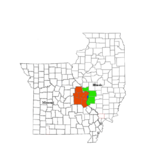Girard, Illinois
Girard | |
|---|---|
 Location of Girard in Macoupin County, Illinois. | |
 Location of Illinois in the United States | |
| Coordinates: 39°26′45″N 89°46′53″W / 39.44583°N 89.78139°W | |
| Country | United States |
| State | Illinois |
| County | Macoupin |
| Area | |
| • Total | 0.94 sq mi (2.42 km2) |
| • Land | 0.94 sq mi (2.42 km2) |
| • Water | 0.00 sq mi (0.00 km2) |
| Elevation | 668 ft (204 m) |
| Population (2010) | |
| • Total | 2,103 |
| • Estimate (2019)[2] | 2,000 |
| • Density | 2,139.04/sq mi (826.09/km2) |
| Time zone | UTC-6 (CST) |
| • Summer (DST) | UTC-5 (CDT) |
| ZIP Code(s) | 62640 |
| Area code | 217 |
| FIPS code | 17-29392 |
| Wikimedia Commons | Girard, Illinois |
Girard is a city in Macoupin County, Illinois, United States. The population was 2,103 at the 2010 census, and 2,010 at a 2018 estimate.
History
Girard is named after Stephen Girard
Geography
Girard is located at 39°26′45″N 89°46′53″W / 39.44583°N 89.78139°W (39.445947, -89.781253).[3]
According to the 2010 census, Girard has a total area of 0.93 square miles (2.41 km2), all land.[4]
Local lakes include Sunset Lake and Otter Lake.
Demographics
| Census | Pop. | Note | %± |
|---|---|---|---|
| 1880 | 1,024 | — | |
| 1890 | 1,524 | 48.8% | |
| 1900 | 1,661 | 9.0% | |
| 1910 | 1,891 | 13.8% | |
| 1920 | 2,387 | 26.2% | |
| 1930 | 1,760 | −26.3% | |
| 1940 | 1,741 | −1.1% | |
| 1950 | 1,740 | −0.1% | |
| 1960 | 1,734 | −0.3% | |
| 1970 | 1,881 | 8.5% | |
| 1980 | 2,246 | 19.4% | |
| 1990 | 2,164 | −3.7% | |
| 2000 | 2,245 | 3.7% | |
| 2010 | 2,103 | −6.3% | |
| 2019 (est.) | 2,000 | [2] | −4.9% |
| U.S. Decennial Census[5] | |||
As of the census[6] of 2000, there were 2,245 people, 864 households, and 565 families living in the city. The population density was 2,398.9 people per square mile (922.1/km2). There were 926 housing units at an average density of 989.5 per square mile (380.4/km2). The racial makeup of the city was 98.93% White, 0.13% African American, 0.13% Native American, 0.04% Asian, 0.09% from other races, and 0.67% from two or more races. Hispanic or Latino of any race were 1.11% of the population.
There were 864 households out of which 34.0% had children under the age of 18 living with them, 48.0% were married couples living together, 12.4% had a female householder with no husband present, and 34.6% were non-families. 28.7% of all households were made up of individuals and 15.2% had someone living alone who was 65 years of age or older. The average household size was 2.49 and the average family size was 3.07.
In the city, the population was spread out with 26.5% under the age of 18, 8.5% from 18 to 24, 28.6% from 25 to 44, 19.3% from 45 to 64, and 17.1% who were 65 years of age or older. The median age was 36 years. For every 100 females, there were 94.0 males. For every 100 females age 18 and over, there were 87.5 males.
The median income for a household in the city was $31,806, and the median income for a family was $39,028. Males had a median income of $29,537 versus $22,266 for females. The per capita income for the city was $15,090. About 10.2% of families and 13.2% of the population were below the poverty line, including 19.8% of those under age 18 and 9.7% of those age 65 or over.
Recreation
Girard is located on the south end of the Sangamon Valley Trail right-of-way.
Notable people
- Hardin B. Cloud, farmer, merchant, and Iowa state legislator, was born in Girard.[7]
- Charlotte Pierce, silent film actress, born in Girard.
- Fountain L. Thompson, U.S. Senator of North Dakota in early 20th Century, was raised in Girard.
References
- ^ "2019 U.S. Gazetteer Files". United States Census Bureau. Retrieved July 14, 2020.
- ^ a b "Population and Housing Unit Estimates". United States Census Bureau. May 24, 2020. Retrieved May 27, 2020.
- ^ "US Gazetteer files: 2010, 2000, and 1990". United States Census Bureau. 2011-02-12. Retrieved 2011-04-23.
- ^ "G001 - Geographic Identifiers - 2010 Census Summary File 1". United States Census Bureau. Archived from the original on 2020-02-13. Retrieved 2015-12-27.
- ^ "Census of Population and Housing". Census.gov. Retrieved June 4, 2015.
- ^ "U.S. Census website". United States Census Bureau. Retrieved 2008-01-31.
- ^ 'Death of H. B. Cloud,' Knoxville Express (Iowa), April 17, 1901, pg. 3


